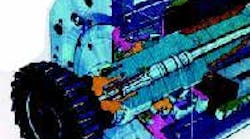An NCMS spindle-development project has created a 75-hp spindle that operates at twice the speed with up to twice the metal-removal rate compared to current technologies.
A four year, $7.5-million spindle-development project headed by The National Center for Manufacturing Sciences (NCMS), Ann Arbor, Mich., has ended with the development of three new spindle designs for high-speed machine tools. These new high-performance spindle prototypes represent both the rolling-element and fluid-film families.
A 75-hp spindle operates at speeds up to 12,000 rpm — twice the speed with up to twice the metal-removal rate of current technologies. This rugged, 480-lb spindle extends the application range of heavy cutting operations.
A 35-hp spindle has consistently high torque and is available from 300 to 20,000 rpm. This spindle delivers new levels of flexibility to both high and low-speed machining operations.
A water-lubricated, self-compensating hydrostatic spindle cluster provides the necessary stiffness to consistently make accurate clusters of closely spaced holes. This translates into fewer process steps and fewer machining stations, which could save U.S. automotive manufacturers, alone, 100,000 machining hours a year.
In addition, development of a new, structured motor-winding technique mitigates the heat-producing proximity effect and is coupled with a new digital controller. Combined, they continuously deliver 30% more torque to the cutting tool. This means that one spindle can cut both steel and aluminum to deliver greater application flexibility.
The National Institute of Standards and Technology Advanced Technology Program (NIST ATP) funded the NCMS project. It also involved the following companies as project-team members: Aesop Inc., Ford Motor Company, General Motors Corporation, Giddings & Lewis, Manufacturing Laboratories Inc., ORSCO Inc., PCC Olofsson, SETCO Sales Company, The Torrington Company, Motorsoft, and MTS Automation 3 /4 Perfor-Controls. mance
"The project team designed, manufactured, and thoroughly evaluated revolutionary, new spindle technologies that will benefit manufacturers worldwide," said Jack McCabe, NCMS vice president of technology. "With the availability of the technical data behind this demonstrated spindle design engineering, manufacturers will be able to avoid costly performance failures by employing some of the most advanced spindle technology ever created."
The findings of this study have been published in a 216-page report.

